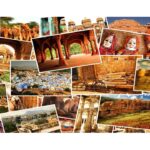1 : City Palace

This palace was built in eighteenth century by Maharaja Jai Singh in in 1729-1732, still the royal family own the palace today and lives here. The palace showcases a mix of Mughal and Rajasthani styles, with grand courtyards, gardens, museums, and beautiful buildings. The entry fee varies from INR 200 for locals to INR 1000 for foreign tourists, and the palace is open daily from 9:30 a.m. to 5:00 p.m.
2: Hawa Mahal

Hawa Mahal, or the “Palace of Winds,” is a well-known monument in Jaipur, Rajasthan. Built in 1799 by Maharaja Sawai Pratap Singh, it stands out for its unique architectural style, featuring 953 small windows, known as jharokhas, made from pink and red sandstone. These windows allow cool air to circulate through the palace, keeping it cool during the hot summer months.
The palace was designed so that royal women, who adhered to strict customs and couldn’t be seen in public, could observe festivals and everyday street life from behind the windows. Its architecture blends Hindu and Islamic styles, with a façade that resembles a honeycomb.
Hawa Mahal, with its museum displaying ancient Rajput artifacts, is a popular tourist attraction. The best time to visit is early in the morning when sunlight illuminates the palace. It’s open daily from 9:30 am to 4:30 pm, and the ideal time to visit Jaipur is between October and March, when the weather is more pleasant.
3: Sheesh Mahal

The Sheesh Mahal, or Mirror Palace, in Jaipur is a beautiful part of the famous Amer Fort. It’s made with mirrors and precious stones, showing the artistic skills of the past. Mirrors are used here not just for looking at yourself but to decorate the palace and make it look stunning.
The story behind its creation is quite interesting. In ancient times, the queen wasn’t allowed to sleep outside but wanted to see the stars while lying down. To fulfill her wish, the king asked the architects to design a palace where mirrors inside would reflect even a small light to look like stars. This way, she could enjoy a starry sky inside the palace.
The Sheesh Mahal is known for its breathtaking design, with tiny mirrors and colored glass covering the walls and ceiling. If just one ray of light enters, the whole room lights up because the mirrors reflect the light everywhere, creating a magical effect like thousands of stars.
In addition to the stunning mirrors, there are beautifully carved pillars, one of which has a flower design that changes color when viewed from different angles. This palace is a perfect example of the rich history and art of Jaipur.
The palace also has a connection to Bollywood. A famous song from the movie “Mughal-E-Azam,” called “Jab Pyar Kiya to Darna Kya,” was shot in the Sheesh Mahal.
To visit the Sheesh Mahal, you go through the Amer Fort. The entry fee is affordable, and it’s best to hire a guide to understand its rich history and architecture. The palace is open from 9:30 AM to 4:30 PM, and it’s recommended to also check out the light show at the fort in the evening.
4: Jantar Mantar

Maharaja Sawai Jai Singh II, who had a deep passion for astronomy and mathematics, built the Jantar Mantar to improve timekeeping, calendar calculations, and celestial navigation. He understood the importance of accurate astronomical observations, not just for science but also for astrology.
The Jantar Mantar is filled with large, unique instruments that serve specific astronomical purposes. Some of the most famous ones include:
- Samrat Yantra (The Supreme Instrument): This giant sundial, which stands 27 meters tall, is the largest in the world. It can measure time with an accuracy of up to 2 seconds.
- Jai Prakash Yantra: Two dome-like structures with crosswires that help astronomers observe the positions of stars and other celestial bodies.
- Ram Yantra: Two large cylinders that measure the altitude and direction of celestial objects.
- Dhruva Yantra: A special instrument used to find the position of the Pole Star, important for navigation.
In 2010, UNESCO recognized Jantar Mantar as a World Heritage Site, acknowledging its historical and cultural importance. It’s one of five such observatories built by Maharaja Jai Singh II, with others in places like Delhi and Varanasi.
Jantar Mantar wasn’t just a beautiful building—it was an important scientific tool used by astronomers to track the movements of the sun, moon, and planets, measure time, and even predict eclipses. It played a major role in the development of astronomy and mathematics in India.
Even today, Jantar Mantar remains relevant. Scientists and astronomers still visit this site to study its instruments and make observations. It’s a place where you can witness how people in the past explored the mysteries of the cosmos.
Visiting Jantar Mantar is like stepping back in time, seeing how the brilliant mind of Maharaja Sawai Jai Singh II helped shape the world of astronomy. It’s a must-see destination for anyone interested in history, science, and culture, and it beautifully shows the link between art and science.
5: Jal Mahal

Jal Mahal, meaning “Water Palace,” was built in the 18th century by Maharaja Madho Singh I as a hunting lodge, not a palace. Located in the middle of Man Sagar Lake in Jaipur, it’s a popular sightseeing spot. Rajasthan once faced a severe drought, causing water shortages. To protect Jaipur’s water supply, Maharaja Pratap Singh reinforced the dam on the nearby river, ensuring the city had enough water. He also renovated his favorite hunting lodge, Jal Mahal, located in the middle of Man Sagar Lake.
However, after years of drought, heavy monsoons returned, causing the lake to rise and submerge the palace. Over time, the palace was neglected and the lake became polluted. Fortunately, in 1999, restoration efforts began, transforming the Jal Mahal back into a beautiful, clean landmark.







